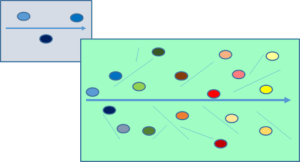Giving Feedback Across Cultures
Dr. Jens Schmidt, A German Executive in Shanghai
Dr. Jens Schmidt is an expat. The company’s corporate headquarters in Stuttgart, Germany, assigned him to improve efficiency at the company’s manufacturing plant in Shangai, China. During his first 90 days he came up with a list of quality issues and he shared this list with three of his direct reports (Mr. Zhu, Mr. Cao and Mrs. Ping).
He asked them for input on how to mitigate the issues within the next 90 days and what the “low hanging fruit” were. He emailed them on Friday evening and asked them to respond by Monday morning, enough time to review over the weekend. While Dr. Jens Schmidt was sorting out his moving goods that finally arrived from Stuttgart and settled into his apartment, Mr. Zhu, Mr. Cao and Mrs. Ping went for lunch. They did not appreciate that they had to leave their families on the weekend but they knew this was important. On Sunday night Mr. Cao, the most senior, eldest and most experienced manager responded to the email.
“Dear Dr. Schmidt, thank you for the trust you are giving to your senior managers by sharing this report with us before sending it to the headquarters. We are fully on board with you and we think you and the quality assurance team in the headquarters will give good guidance on how to mitigate the issues presented in the report. We kindly ask that you inform us of any changes once you have discussed this report with the headquarters. With kind regards, Mr. Cao”.
On Monday, when Dr. Schmidt came back to the office, Mr. Zhu handed in his resignation. Two weeks later Mr. Cao and Mrs. Ping also resigned.
Now, Dr. Schmidt had to lead 50 engineers directly. He was using everything he knew that worked in Germany — especially in terms of performance appraisal, and yet the Chinese employees seemed to be losing efficiency and effectiveness by the week. After 90 days, many engineers had moved to other companies and Dr. Schmidt had a hard time to explain to HR why he needed to hire new engineers and managers in the middle of a global crisis. His 180 days report looked bleak. The quality issues had become worse and Dr. Schmidt had nothing to show for but failure.
It took quite some time and effort on Dr. Schmidt’s part to recognize that what worked in Germany in terms of critical and to-the-point feedback was actually demotivating to the Chinese employees, who were used to more positive reinforcement than pure critique. These positive comments motivated them to increase productivity and put forth that extra, discretionary effort. Once Dr. Schmidt changed his feedback and his communication style in general he noticed that productivity improved again. He was also able to win the managers and some of the employees back once he understood the importance of relationships and the concept of “face” in the Chinese culture.
Three years later he managed to leave the country with a good feeling.
Feedback is Completely Misconstrued
According to the original mechanistic definition feedback occurs when an environment reacts to an action or behavior. For example, ‘customer feedback’ is the buyer’s reaction to a firm’s products and policies, and ‘operational feedback’ is the internally generated information on a firm’s performance.
Originally, the idea was that feedback changes behavior. Criticism or praise is considered feedback only if it brings about a lasting change in the recipient’s behavior. While I am generally critical of this assumption, I would like to explain here three major feedback styles that I have seen over my career. Often they work in a monocultural setting or when they are framed well. For example, critiques work well for writers and bloggers, the sandwich works well in an Anglo-Saxon environment and Hindi-style generally works well in Asia, the Middle East and Africa.
One major issue is that feedback often is NOT delivered well. Another issue is that often it is full of projections and that it has to be abused to justify why a good performer was not promoted. That is one of the key issues with feedback. For the next three styles we will assume that the feedback is well delivered, the feedback receiver asked for feedback and the feedback is not used as a justification for non-promotion or a performance rating.
German-Style: Pure Direct Critique

Clearly, people in Germany do not generally provide and receive feedback in the same way that people in China are used to doing. In fact, appraisal feedback can be very different across different cultures. Although not many like to do it, we know that critiquing – in a constructive and empowering way – others’ work is a crucial part of a manager’s job. However, critiquing someone often brings unwanted results and ends up hurting others even when this wasn’t the initial goal. This generally happens because criticism embodies two of the things that human beings hate the most, i.e. it calls for submission and it devalues.
With a focus on what needs to be improved, this method works extremely well for writers, bloggers and co-creators. In many instances, authors actually request it. It’s also often used in educational circumstances, training contexts and examinations. Here it is important to focus on the work, instead of the person. For example, “In this report, capitalization is not applied consistently.” or “This paragraph is hard to understand because it contains a lot of passive constructions.” Germans love “Sachlichkeit” so the focus here is on the object, the piece of art, the work output, rather than the person delivering the work. The intention here is to improve the overall quality of the work output.
US-Style: The Sandwich Feedback
The original sandwich feedback technique entails something positive to warm up the discussion, followed by some criticism which is the real feedback one wants to give, and it wraps up with more praise, i.e. again something positive to soften the actual feedback. In other words, the sandwich feedback method involves discussing corrective feedback that is “sandwiched” between two layers of praise.
There are two ways to put the sandwich feedback technique in practice:
- You start off with a positive comment, add constructive feedback with an explanation of how to improve, and end with another positive comment.
- You begin with a contextual statement (I liked…because…Now/Next time…) and conclude with an interactive statement, e.g. a question based on the work done.

This method is particularly helpful to managers when they want to discuss problems with the employee’s behavior. It is especially useful for those managers who find it difficult to deliver corrective feedback. It is important to note that you need to ask for permission to give feedback and also find examples of where you observe what you find worth changing. Here you should focus on behavior, rather than the person and soften it with “tend to” and “I observed” and “what this does with me…”. Speak about how it affects you. This approach takes the name of Non-Violent Communication (NVC) and it was developed by the American psychologist M. Rosenberg.
Hindi-Style: Focus on the Positive

In Bangalore, I learned another feedback style which I call “Hindi-Style Feedback”. Basically, here you focus on the positive and remain silent on the negative. In order to save face you don’t confront the person you are addressing directly. If you have negative feedback you would tell this to an intermediary who then decides about how to approach the topic with the person.
This method works well in the Asian context or when you generally already have a high-performing team and nothing major goes wrong. Focussing and reinforcing the strengths and the positive behavior will lift employees up and encourage them to do more of this behavior. Also, I think it is important to build a personal relationship before delivering feedback and better to deliver it 1:1. If you are only correcting errors and you have agreed a more direct style to do that it is acceptable if you have a good relationship with your team members.
In the SIETAR conference in Dublin in a pre-congress workshop my colleague Adrienne Rubatos and I co-created a feedback map with the participants.

We also suggested that feedback usually creates more harm than support and as humanistic coaches we therefore would propose to stop using performance management systems, Management by Objectives and certainly feedback. Where we feel feedback is helpful ONLY would be in learning situations, transitions and when it is explicitly demanded by the feedback-receiver.
I’m aware that this is a complete paradigm shift and that it will change our approaches to promotions, compensation, benefits, hierarchy and basically completely turn around how we work in organizations.
We are demanding a new approach to feedback. We promote an approach that is mindful, supportive and transcultural.
Delivering Feedback like a Global Virtual Leader
Even if in a new cultural setting it’s useful to learn the cultural rules, perhaps through a cultural mentor, don’t assume that “going native” is always and necessarily successful. Most of the time, you will have to adjust your feedback style and create a blend with which you feel comfortable enough in the given setting and with the person you have in front of you.
More and more often teams are global virtual teams (GVT) and there are no rules other than the rules the teams co-create. We have vast experience working within global, virtual teams and you find further blog posts via https://globalpeopletransitions.com/?s=global+virtual+teams.
Alternatively, you can join our RockMe! program or the RockMeRetreat where we discuss these matters based on your leadership challenges.

